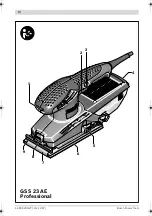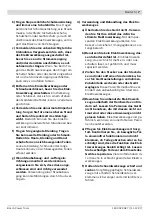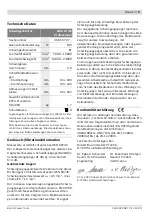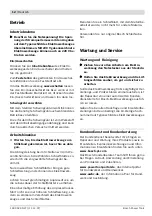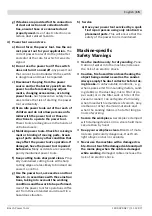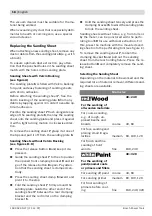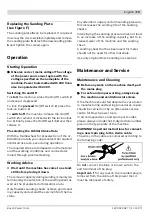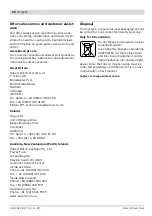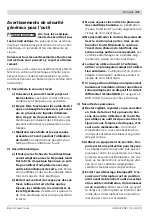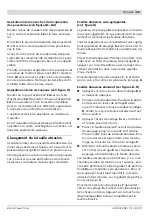
English |
15
Bosch Power Tools
1 609 929 N27 | (11.12.07)
g) If devices are provided for the connection
of dust extraction and collection facili-
ties, ensure these are connected and
properly used.
Use of dust collection can
reduce dust-related hazards.
4) Power tool use and care
a) Do not force the power tool. Use the cor-
rect power tool for your application.
The
correct power tool will do the job better
and safer at the rate for which it was de-
signed.
b) Do not use the power tool if the switch
does not turn it on and off.
Any power tool
that cannot be controlled with the switch
is dangerous and must be repaired.
c) Disconnect the plug from the power
source and/or the battery pack from the
power tool before making any adjust-
ments, changing accessories, or storing
power tools.
Such preventive safety meas-
ures reduce the risk of starting the power
tool accidentally.
d) Store idle power tools out of the reach of
children and do not allow persons unfa-
miliar with the power tool or these in-
structions to operate the power tool.
Power tools are dangerous in the hands of
untrained users.
e) Maintain power tools. Check for misalign-
ment or binding of moving parts, break-
age of parts and any other condition that
may affect the power tool’s operation. If
damaged, have the power tool repaired
before use.
Many accidents are caused by
poorly maintained power tools.
f) Keep cutting tools sharp and clean.
Prop-
erly maintained cutting tools with sharp
cutting edges are less likely to bind and are
easier to control.
g) Use the power tool, accessories and tool
bits etc. in accordance with these instruc-
tions, taking into account the working
conditions and the work to be performed.
Use of the power tool for operations differ-
ent from those intended could result in a
hazardous situation.
5) Service
a) Have your power tool serviced by a quali-
fied repair person using only identical re-
placement parts.
This will ensure that the
safety of the power tool is maintained.
Machine-specific
Safety Warnings
f
Use the machine only for dry sanding.
Pene-
tration of water into the machine increases
the risk of an electric shock.
f
Caution, fire hazard! Avoid overheating the
object being sanded as well as the sander.
Always empty the dust collector before tak-
ing breaks.
In unfavourable conditions, e. g.,
when sparks emit from sanding metals, sand-
ing debris in the dust bag, micro filter or pa-
per sack (or in the filter sack or filter of the
vacuum cleaner) can self-ignite. Particularly
when mixed with remainders of varnish, poly-
urethane or other chemical materials and
when the sanding debris is hot after long pe-
riods of working.
f
Secure the workpiece.
A workpiece clamped
with clamping devices or in a vice is held more
secure than by hand.
f
Keep your workplace clean.
Blends of mate-
rials are particularly dangerous. Dust from
light alloys can burn or explode.
f
Never use the machine with a damaged ca-
ble. Do not touch the damaged cable and pull
the mains plug when the cable is damaged
while working.
Damaged cables increase the
risk of an electric shock.
OBJ_BUCH-80-002.book Page 15 Tuesday, December 11, 2007 8:02 AM



